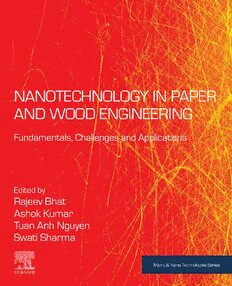Table Of ContentNanotechnology in Paper
and Wood Engineering
This pageintentionallyleftblank
Nanotechnology in Paper
and Wood Engineering
Fundamentals, Challenges and
Applications
Edited by
RAJEEV BHAT
FoodBy-Products Valorization Technologies (ERA- Chair in
VALORTECH), EstonianUniversity of Life Sciences,Tartu, Estonia,EU
ASHOK KUMAR
Departmentof Biotechnologyand Bionformatics, Jaypee University of
InformationTechnology, Waknaghat, India
TUAN ANH NGUYEN
Institute forTropical Technology, Vietnam Academyof Science and
Technology, Hanoi,Vietnam
SWATI SHARMA
University Institute of Biotechnology, Chandigarh University,
Mohali, India
Elsevier
Radarweg29,POBox211,1000AEAmsterdam,Netherlands
TheBoulevard,LangfordLane,Kidlington,OxfordOX51GB,UnitedKingdom
50HampshireStreet,5thFloor,Cambridge,MA02139,UnitedStates
Copyright©2022ElsevierInc.Allrightsreserved.
Nopartofthispublicationmaybereproducedortransmittedinanyformorbyanymeans,
electronicormechanical,includingphotocopying,recording,oranyinformationstorageand
retrievalsystem,withoutpermissioninwritingfromthepublisher.Detailsonhowtoseek
permission,furtherinformationaboutthePublisher’spermissionspoliciesandourarrangements
withorganizationssuchastheCopyrightClearanceCenterandtheCopyrightLicensingAgency,
canbefoundatourwebsite:www.elsevier.com/permissions.
Thisbookandtheindividualcontributionscontainedinitareprotectedundercopyrightbythe
Publisher(otherthanasmaybenotedherein).
Notices
Knowledgeandbestpracticeinthisfieldareconstantlychanging.Asnewresearchand
experiencebroadenourunderstanding,changesinresearchmethods,professionalpractices,or
medicaltreatmentmaybecomenecessary.
Practitionersandresearchersmustalwaysrelyontheirownexperienceandknowledgein
evaluatingandusinganyinformation,methods,compounds,orexperimentsdescribedherein.In
usingsuchinformationormethodstheyshouldbemindfuloftheirownsafetyandthesafetyof
others,includingpartiesforwhomtheyhaveaprofessionalresponsibility.
Tothefullestextentofthelaw,neitherthePublishernortheauthors,contributors,oreditors,
assumeanyliabilityforanyinjuryand/ordamagetopersonsorpropertyasamatterofproducts
liability,negligenceorotherwise,orfromanyuseoroperationofanymethods,products,
instructions,orideascontainedinthematerialherein.
BritishLibraryCataloguing-in-PublicationData
AcataloguerecordforthisbookisavailablefromtheBritishLibrary
LibraryofCongressCataloging-in-PublicationData
AcatalogrecordforthisbookisavailablefromtheLibraryofCongress
ISBN:978-0-323-85835-9
ForInformationonallElsevierpublications
visitourwebsiteathttps://www.elsevier.com/books-and-journals
Publisher:MatthewDeans
AcquisitionsEditor:SimonHolt
EditorialProjectManager:GabrielaD.Capille
ProductionProjectManager:DebasishGhosh
CoverDesigner:GregHarris
TypesetbyMPSLimited,Chennai,India
Contents
Listofcontributors xv
Preface xxi
Part I Fundamentals
1. Nanotechnology in paper and wood engineering: anintroduction 3
AshokKumar,TuanAnhNguyen,SwatiSharmaandRajeevBhat
1.1 Introduction 3
1.2 Applicationsofnanotechnologyinthepaperandpulpindustry 4
1.3 Applicationsofnanotechnologyinthewoodindustry 6
1.4 Conclusion 8
References 9
2. Nanofibersfor the paper industry 15
PawełChmielarzandIzabelaZaborniak
2.1 Paperindustry:challenges 15
2.2 Nanofibers:characteristics 16
2.3 Cellulosenanofibers 17
2.3.1 TypesofCNFinpapermanufacturing 18
2.3.2 ThemechanismofCNFstrengtheningproperties 21
2.3.3 CNFasanadditiveinpaperindustry 23
2.3.4 CNFascoatingmaterialinpapermaking 26
2.4 Lignocellulosicnanofibers 28
2.5 Conclusionsandfutureprospective 29
References 30
3. Roleof laccase inthe pulp andpaper industry 35
AsimHussain,MuhammadBilal,HamzaRafeeq,ZaraJabeen,NadiaAfsheen,FarooqSher,
VineetKumar,RamNareshBharagava,LuizFernandoRomanholoFerreiraand
HafizM.N.Iqbal
3.1 Introduction 35
3.2 Laccases,redoxpotential,anddelignification 37
3.3 Laccases-assistedbiobleaching/delignificationofpulps 38
3.4 Laccasemediators 39
3.4.1 Naturalmediators 39
3.4.2 Artificialmediators 40
v
vi Contents
3.5 Lignindegradationbylaccase-mediatorsystem 41
3.6 Biobleachingbylaccase-mediatorsystem 44
3.7 Effectoflaccaseandxylanaseonbiobleaching 45
3.8 Laccaseutilizationforpulpbiografting 46
3.9 Pitchcontrolbylaccases 47
3.10 DeinkingofwastepapersbyLMS 48
3.11 Laccase-mediatedtreatmentofpulpandpaperindustryeffluents 49
3.12 Lignintransformationbylaccases 50
3.13 Recoveryofligninbyproducts 51
3.14 Laccaseforbiofuelssynthesis 51
3.15 Oxygenroleinbiobleachingofpulp 52
3.16 Challengestoimplementlaccaseatindustriallevel 53
3.17 Recombinantlaccasesinbiobleachingofpulps 54
3.18 Conclusionandperspectives 55
Acknowledgment 56
Conflictofinterests 56
References 56
4. Nanotechnologyfor waste woodrecycling 61
K.M.FaridulHasan,PéterGyörgyHorváthandTiborAlpár
4.1 Introduction 61
4.2 Woodwastematerials 64
4.3 Nanotechnology 66
4.3.1 Nanographene 68
4.3.2 Nanotitaniumdioxide 69
4.3.3 Nanosilicondioxide 69
4.3.4 NanoZnO 70
2
4.3.5 Carbonnanotube 72
4.4 W@W-basednanocomposites 73
4.5 Summary 75
References 75
5. Synthesis andcharacterization ofbiodegradablecellulose-based
polymer hydrogel 81
KiplangatRop,GeorgeN.KarukuandDamarisMbui
5.1 Introduction 81
5.2 Materialsandmethods 85
5.2.1 Materials 85
5.2.2 Samplepreparation 85
5.2.3 Characterizationofwaterhyacinth 86
5.2.4 Isolationofcellulosefromwaterhyacinth 86
Contents vii
5.2.5 Synthesisofwaterhyacinthcellulose-g-poly(ammoniumacrylate-co-acrylicacid)
polymerhydrogel 87
5.2.6 Structuralandmorphologicalcharacterization 88
5.2.7 Evaluatingtheswellingofpolymerhydrogel 89
5.2.8 Biodegradationtest 90
5.2.9 Preparationofnanocompositepolymerhydrogel 91
5.2.10 Statisticaldataanalysis 92
5.3 Resultsanddiscussion 92
5.3.1 Compositionofwaterhyacinth 92
5.3.2 Mechanismofgraftpolymerizationandextractionofhomopolymer 93
5.3.3 Structuralandmorphologicalcharacteristicsofwaterhyacinth,isolatedcellulose,
andcellulose-graftedcopolymer 96
5.3.4 Evaluationofthefactorsinfluencingtheswellingofcellulose-graftedpolymer
hydrogel 102
5.3.5 Biodegradationofcellulose-graftedcopolymer 106
5.3.6 Waterabsorbencyofcellulose-g-poly(acrylamide-co-acrylicacid)/nano-HA
compositehydrogel 111
5.3.7 Structuralandmorphologicalcharacteristicsofcellulose-graftednanocomposite
polymerhydrogel 112
5.4 Conclusion 118
Acknowledgments 118
References 119
6. Fabrication of nanowoodsand nanopapers 125
NikitaGoswami,TusharKumarandPalakjotK.Sodhi
6.1 Introduction 125
6.2 Celluloseandnanocellulose 126
6.3 Isolationandfabricationofnanocellulosefibrils 127
6.4 Productsofnanocellulose:nanowoodandnanopaper 129
6.4.1 Nanowood 129
6.4.2 Nanopaper 132
6.5 Conclusion 138
References 139
7. Pulpand paper industry-based pollutants,andtheiradverse impacts 143
KomalRizwan,TahirRasheed,MuhammadBilalandHafizM.N.Iqbal
7.1 Introduction 143
7.2 Wasteeffluentsfromthepulpandpaperindustry 145
7.3 Pollutantsfrompulpandpaperindustry:categoriesandcharacteristics 145
7.4 Adversehealthimpactsofpulpandpaperindustrypollutants 146
7.5 Environmentalimplicationsregardingpulpandpaperindustrywaste 147
7.6 Techniquesforwastewatertreatment 149
viii Contents
7.7 Wastetovalueaspects 153
7.8 Conclusion 154
Acknowledgment 155
Conflictofinterests 155
References 155
Furtherreading 160
Part II Applications
8. Pharmaceutical applications of nanocellulose 163
ShwetaMishraandAnilM.Pethe
8.1 Introduction 163
8.2 Methodsofpreparation 163
8.2.1 Acidhydrolysisfornanocellulosepreparation 164
8.3 ApplicationofNCC 165
8.4 Conclusion 171
References 171
9. Nano-biodegradation of plasticmaterials 175
AlcidesLopesLeão,IvanaCesarino,MilenaChanesdeSouza,OtavioAugustoTittonDias
andMohammadJawaid
9.1 Introduction 175
9.2 Applications 176
9.3 Nanocellulose 177
9.3.1 Cellulosenanofibers 179
9.3.2 Cellulosenanocrystals 180
9.4 Degradability 182
9.4.1 Degradation 184
9.4.2 Biodegradation 185
9.5 Nonbiodegradablepolymers 186
9.6 Bioplastics 187
9.7 Biodegradablepolymers 189
9.8 Effectofnanocelluloseonbiodegradability 190
9.9 Conclusions 191
References 191
10. Production ofmicrofibrillatedcellulose fibers and their application in
polymeric composites 197
MingLiu,KatrinGretaHoffmann,ThomasGeigerandGustavNyström
10.1 Microfibrillatedcellulosefiberproduction 197
10.1.1 Microstructureofmicrofibrillatedcellulose 197
Contents ix
10.1.2 Chemicalcompositionofmicrofibrillatedcellulose 197
10.1.3 Techniquesformicrofibrillatedcellulosefiberproduction 198
10.2 Microfibrillatedcelluloseapplicationinpolymericcomposites 206
10.2.1 Microfibrillatedcelluloseinnaturalpolymers 208
10.2.2 Microfibrillatedcelluloseinthermoplastics 213
10.2.3 Microfibrillatedcelluloseinthermosets 216
10.2.4 Microfibrillatedcelluloseinelastomers 219
10.3 Futureperspectives 221
References 222
11. Nanotechnology: application and potentials for heterogeneous catalysis 231
NishanthIgnatius,AnthonyPoblete,AleksaKrunic,PeterMa,
NishilGosalia,TayyubAliandYaserDahman
11.1 Introduction 231
11.2 Dehalogenationandhydrogenationreactions 232
11.2.1 Catalyticapplicationofbiogenicplatinumnanoparticlesforhydrogenation
ofcinnamaldehydetocinnamylalcohol 233
11.2.2 Excellentcatalyticpropertiesovernanocompositecatalystsforselective
hydrogenationofhalnitrobenzenes 234
11.2.3 Anefficientandreusableheterogeneouscatalystfordehalogenationreaction 235
11.2.4 Lookingtothefuture 236
11.3 Hydrosilylationreactions 237
11.3.1 Advancementovertheyears:platinum-basedcatalysts 238
11.3.2 Recentbreakthroughsinplatinumcatalysts 238
11.3.3 Heterogeneousversushomogeneouscatalystsinhydrosilylation:
nanotechnologyapplications 239
11.3.4 Platinum-supportednanoparticles 239
11.3.5 Leach-proofandsinter-proofcatalysts 240
11.3.6 Alookintothefutureofheterogeneouscatalystsinhydrosilylation 241
11.4 C(cid:1)Ccouplingreactions 241
11.4.1 Catalysts 242
11.4.2 Nanoparticlesascatalysts 244
11.4.3 UseofnanoparticlesinHeckreaction 244
11.4.4 UseofnanoparticlesinSonogashirareaction 245
11.4.5 UseofnanoparticlesintheStillereaction 245
11.5 Fuelcelltechnology 246
11.6 Platinumcatalysts 247
11.6.1 Platinumnanoparticles 248
11.6.2 Alternativecatalystsmaterial 248
11.6.3 Supportingmaterials 249
11.6.4 Fuelcelloutlook 251
11.7 Heavyoiltechnology 252

